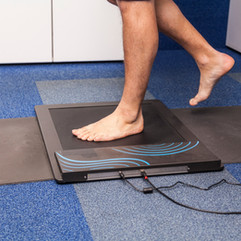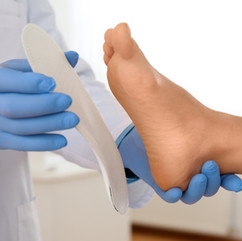Understanding and Managing Morton's Neuroma: Insights into Symptoms, Treatment, and Prevention
- Mustafa Alnaib

- Dec 21, 2023
- 6 min read
Definition and Overview
Morton's Neuroma is a foot condition that causes significant discomfort, primarily impacting the area between the toes. This condition arises from the thickening of the nerve tissue leading to the toes, most commonly between the third and fourth toes. The thickening results from the compression and irritation of the nerve, leading to inflammation and, consequently, pain.
This condition is named after Thomas George Morton, who first described it in 1876. Despite its name, Morton's Neuroma is not actually a true neuroma as it does not involve a tumor or growth. Instead, it's more accurately described as a perineural fibrosis, where the tissue around the nerve becomes fibrous and thickened.

Prevalence and Demographic Most Affected
Morton's Neuroma predominantly affects middle-aged individuals, with a higher incidence reported among women compared to men. This disparity is often attributed to footwear choices, such as high heels or tight shoes, which place excessive pressure on the toes and forefoot. Athletes, particularly those engaged in sports that involve running and pressure on the feet, may also be at an increased risk.
The prevalence of Morton's Neuroma is not precisely known, as many cases may go undiagnosed or misdiagnosed. However, it is considered a common foot disorder, especially among those who are active or wear ill-fitting footwear regularly.

Anatomy of the Foot Related to Morton's Neuroma
The human foot is a complex structure composed of bones, ligaments, muscles, and nerves. Central to the development of Morton's Neuroma is the area around the metatarsal bones, which are the long bones found in the forefoot. Between these bones lie the interdigital nerves, responsible for providing sensation to the toes.
In the case of Morton's Neuroma, the focus is often on the area between the third and fourth metatarsal bones. Here, the interdigital nerve, primarily the lateral branch of the medial plantar nerve, is subjected to pressure and irritation.

How and Why Morton's Neuroma Develops
Morton's Neuroma develops as a response to chronic stress and pressure on the interdigital nerve. When the metatarsal bones repeatedly compress the nerve, it leads to irritation and inflammation. Over time, this repeated trauma causes the nerve to thicken, forming a benign growth known as a neuroma.
Several factors contribute to the development of Morton's Neuroma. These include:
Footwear: Tight, narrow shoes or high heels can increase pressure on the forefoot, compressing the nerves.
Foot Deformities: Conditions such as flat feet, high arches, or bunions can alter the alignment of the metatarsal bones, increasing the likelihood of nerve compression.
High-Impact Activities: Activities that put repeated pressure on the forefoot, such as running or sports that involve jumping, can contribute to the development of Morton's Neuroma.

Common Symptoms Experienced by Patients
Morton's Neuroma typically manifests as pain in the forefoot, especially between the third and fourth toes. Patients often describe this pain as feeling like they are walking on a pebble or a fold in their sock. The pain can be sharp, burning, or aching in nature. In some cases, there may also be tingling, numbness, or a sensation of swelling in the affected area, even when there is no visible swelling.
The symptoms usually worsen over time and are often exacerbated by wearing tight shoes or engaging in activities that place pressure on the foot, such as running or walking. Some patients find relief by removing their shoes, massaging the foot, or resting.

Methods and Criteria for Diagnosing Morton's Neuroma
The diagnosis of Morton's Neuroma is primarily clinical, based on the patient's history and physical examination. During the examination, the healthcare provider will palpate the foot to locate the tender spot and may perform manoeuvres, such as squeezing the foot (Mulder's sign), to reproduce the symptoms.
Imaging studies, such as ultrasound or magnetic resonance imaging (MRI), are sometimes used to confirm the diagnosis and rule out other conditions, such as stress fractures or arthritis. These imaging modalities can visualise the thickened nerve and help in the assessment of its size and the presence of other foot abnormalities.
Diagnosing Morton's Neuroma involves differentiating it from other conditions that cause similar symptoms, such as metatarsalgia, bursitis, or rheumatoid arthritis.

Treatment Options for Morton's Neuroma
Conservative Management Strategies
The initial approach to treating Morton's Neuroma typically involves conservative, non-surgical methods. These strategies aim to alleviate pain and reduce pressure on the affected nerve. Key conservative treatments include:
Footwear Modifications: Selecting shoes with a wide toe box and low heels can significantly reduce compression on the nerves in the forefoot. Avoiding high heels and tight-fitting shoes is crucial.
Orthotic Devices: Custom orthotics or over-the-counter padded shoe inserts can help redistribute pressure away from the neuroma. These devices provide cushioning and support, reducing the stress on the foot.
Medications: Nonsteroidal anti-inflammatory drugs (NSAIDs) like ibuprofen or naproxen can be used to manage pain and reduce inflammation. In some cases, corticosteroid injections may be administered to the affected area to decrease swelling and pain.
Physical Therapy: Stretching exercises targeting the gastrocnemius muscle, Achilles tendon, and plantar fascia. These stretches aim to alleviate tension in the lower leg and foot, thereby reducing stress on the forefoot. Stretching the gastrocnemius muscle and Achilles tendon is crucial, as tightness in these areas can lead to increased pressure on the forefoot. Similarly, stretching the plantar fascia helps in relieving pressure and improving foot mechanics.
Surgical Options and When They Are Considered
Surgery is considered when conservative treatments fail to provide relief and the pain significantly impacts daily activities. The two main surgical options are:
Neurectomy: This procedure involves removing the affected nerve segment. It can provide permanent relief but may result in permanent numbness in the toes.
Decompression Surgery: Instead of removing the nerve, this technique involves cutting nearby structures, such as the ligaments binding the bones in the forefoot, to relieve pressure on the nerve.
Both surgical options carry risks, such as infection, numbness, or recurrence of pain. The decision to undergo surgery should be made in consultation with a healthcare professional, considering the patient's individual condition and lifestyle.

Prevention and Lifestyle Modifications for Morton's Neuroma
Tips for Preventing Morton's Neuroma
Preventing Morton's Neuroma involves addressing the factors that increase the risk of developing this condition. Key preventive measures include:
Choosing the Right Footwear: Selecting shoes with a wide toe box and adequate cushioning is crucial. High heels and tight shoes should be avoided as they can compress the toes and aggravate the condition.
Regular Foot Care: Regular check-ups, especially for individuals with foot deformities (like high arches or flat feet), can help in early identification and management. Self-examination of feet for any signs of changes or discomfort is also beneficial.
Weight Management: Maintaining a healthy weight can reduce the stress and pressure on the feet, lowering the risk of developing Morton's Neuroma.
Lifestyle Changes That Can Alleviate Symptoms
For individuals experiencing symptoms of Morton's Neuroma or those prone to it, the following lifestyle modifications can be helpful:
Foot Exercises: Engaging in exercises that stretch and strengthen the foot muscles can improve foot mechanics and alleviate pressure on the nerve.
Activity Modification: Activities that put excessive pressure on the forefoot should be modified. Alternative exercises like swimming or cycling, which put less stress on the feet, can be beneficial.
Rest and Ice: For acute pain, resting the affected foot and applying ice can help reduce inflammation and alleviate symptoms.
Implementing these preventive and lifestyle strategies can significantly impact the management and prevention of Morton's Neuroma, offering a proactive approach to those at risk or already experiencing symptoms.

Conclusion
In this article, we have explored Morton's Neuroma, a common foot condition characterised by the thickening of nerve tissue between the toes. We discussed its anatomy and pathophysiology, highlighting how repetitive pressure and irritation lead to this painful condition. The symptoms, ranging from sharp pain to numbness, and the methods for diagnosing Morton's Neuroma, including clinical examination and imaging, were detailed. Treatment options, both conservative and surgical, were outlined, offering insight into the various approaches to managing this condition.
Additionally, we emphasised the importance of preventive measures and lifestyle modifications. Choosing the right footwear, engaging in appropriate foot exercises, and maintaining a healthy weight are crucial steps in preventing Morton's Neuroma. For those already experiencing symptoms, modifications in daily activities and self-care practices can provide significant relief.
It's important to remember that while this article provides comprehensive information on Morton's Neuroma, it is not a substitute for professional medical advice. Individuals experiencing foot pain or symptoms suggestive of Morton's Neuroma should consult a healthcare professional for a proper diagnosis and treatment plan.
About the Author: Dr. Mustafa Alnaib MBChB, MRCS, MSc, FEBOT is an orthopaedic surgeon, musculoskeletal doctor and Clinic Director at ACTIVATE Musculoskeletal Clinic in Kent












Comments